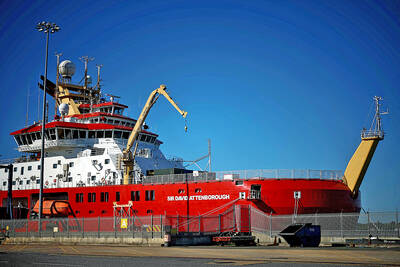NASA is supposed to seek out almost all the asteroids that threaten Earth, but lacks the money to do the job, a federal report found.
That is because even though Congress assigned the space agency the mission four years ago, it never gave NASA the money to build the necessary telescopes, said the report, released yesterday by the National Academy of Sciences.
Specifically, NASA has been ordered to spot 90 percent of potentially deadly rocks hurtling through space by 2020.
Even without the money, NASA said it has completed about one-third of its assignment with its current telescope system.
The agency estimated that about 20,000 asteroids and comets in Earth’s solar system bigger than 140m in diameter are potential threats to the planet. That is slightly smaller than the Superdome sports arena in New Orleans, Louisiana. So far, scientists know where about 6,000 of the objects are.
Rocks between 140m and 1,000m in diameter can devastate an entire region, but not the entire globe, said Lindley Johnson, NASA’s manager of the near-Earth objects program. Objects bigger than that are even more threatening, of course.
Just last month, astronomers were surprised when an object of unknown size and origin bashed into Jupiter and created an Earth-sized bruise that still is spreading. Jupiter gets slammed more often than Earth because of its immense gravity, enormous size and location.
Disaster movies like Armageddon and near misses in previous years frightened people and alerted them to a serious issue. But when it comes to doing something about monitoring the threat, the academy concluded: “There has been relatively little effort by the US government.”
And the US government is practically the only government doing anything at all, the report found.
“It shows we have a problem we’re not addressing,” said Louis Friedman, executive director of the Planetary Society, an advocacy group.
NASA calculated that to spot the asteroids as required by law would cost about US$800 million between now and 2020, either with a new ground-based telescope or a space observation system, Johnson said. If NASA received only US$300 million, it could find most asteroids bigger than 305m across, he said.
But so far NASA has gotten neither.
It may never get the money, said John Logsdon, a space policy professor at George Washington University.
There is not a big enough group pushing for the money, he said.
At the moment, NASA has identified about five near-Earth objects that pose better than a one-in-a-million risk of hitting the planet and being big enough to cause serious damage, Johnson said. That number changes from time to time, usually with new asteroids added and old ones removed as more information is gathered on their orbits.

FRUSTRATIONS: One in seven youths in China and Indonesia are unemployed, and many in the region are stuck in low-productivity jobs, the World Bank said Young people across Asia are struggling to find good jobs, with many stuck in low-productivity work that the World Bank said could strain social stability as frustrations fuel a global wave of youth-led protests. The bank highlighted a persistent gap between younger and more experienced workers across several Asian economies in a regional economic update released yesterday, noting that one in seven young people in China and Indonesia are unemployed. The share of people now vulnerable to falling into poverty is now larger than the middle class in most countries, it said. “The employment rate is generally high, but the young struggle to

STEPPING UP: Diminished US polar science presence mean opportunities for the UK and other countries, although China or Russia might also fill that gap, a researcher said The UK’s flagship polar research vessel is to head to Antarctica next week to help advance dozens of climate change-linked science projects, as Western nations spearhead studies there while the US withdraws. The RRS Sir David Attenborough, a state-of-the-art ship named after the renowned British naturalist, would aid research on everything from “hunting underwater tsunamis” to tracking glacier melt and whale populations. Operated by the British Antarctic Survey (BAS), the country’s polar research institute, the 15,000-tonne icebreaker — boasting a helipad, and various laboratories and gadgetry — is pivotal to the UK’s efforts to assess climate change’s impact there. “The saying goes

ENERGY SHIFT: A report by Ember suggests it is possible for the world to wean off polluting sources of power, such as coal and gas, even as demand for electricity surges Worldwide solar and wind power generation has outpaced electricity demand this year, and for the first time on record, renewable energies combined generated more power than coal, a new analysis said. Global solar generation grew by a record 31 percent in the first half of the year, while wind generation grew 7.7 percent, according to the report by the energy think tank Ember, which was released after midnight yesterday. Solar and wind generation combined grew by more than 400 terawatt hours, which was more than the increase in overall global demand during the same period, it said. The findings suggest it is

TICKING CLOCK: A path to a budget agreement was still possible, the president’s office said, as a debate on reversing an increase of the pension age carries on French President Emmanuel Macron yesterday was racing to find a new prime minister within a two-day deadline after the resignation of outgoing French Prime Minister Sebastien Lecornu tipped the country deeper into political crisis. The presidency late on Wednesday said that Macron would name a new prime minister within 48 hours, indicating that the appointment would come by this evening at the latest. Lecornu told French television in an interview that he expected a new prime minister to be named — rather than early legislative elections or Macron’s resignation — to resolve the crisis. The developments were the latest twists in three tumultuous